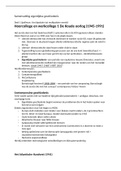Summary
Summary 2024 Assignment 2 Specification Financial Modelling DSC2604 Semester 1
- Course
- Institution
Assignment 2 Specification Financial Modelling DSC2604 - Semester 1................ Give the net present value (NPV) and the profitability index (PI) of the project assuming a discount rate of 6% per annum. (2) b. Would you regard the investment as a good investment? Motivate your answe...
[Show more]












